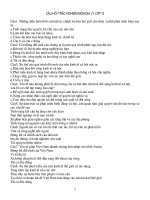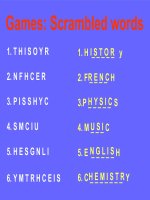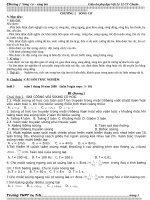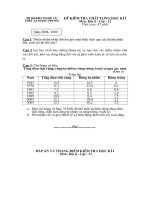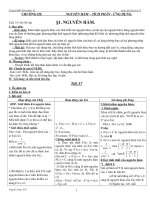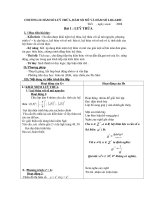unit3 12 Cb
Bạn đang xem bản rút gọn của tài liệu. Xem và tải ngay bản đầy đủ của tài liệu tại đây (136.99 KB, 14 trang )
CHU VAN AN SCHOOL
TEACHING PLAN
Prepared by Nguyen Thi Thu Huong Period: UNIT 3 : WAYS OF SOCIALIZING
(A / READING )
Date of preparation: August 20
th
- 2009
Class: 12C1,C2,A2,A4
I/ AIMS:
- By the end of the lesson Ss will be able:
1/ Knowledge: to guess the meaning in context and undersatnd the passage about ways of socializing.
2/ Skill : to guess the meaning in context and read for gist and for specific information
3/ Attitude:
II/ PREPARATIONS:
- Notebooks, chalks, board.
III/ PROCEDURES
Time
Teacher’s
Activities
Students’
activities
Contents of lesson
+ Put Ss into groups of
four or five
+ Tell Ss to match the
gestures with their
meanings.
• .LEAD IN
+ Do you often use these
gestures to communicate ?
+ Do other people
understand you ?
When you want to attract
someone’s attention , you
might speak to them .
Speech is one of the most
important ways of
communicating, which is
called verbal form of
communication. Or you
can move your hands by
waving, use gestures,
which are called non-
verbal form of
communication.
+ Today, you get to know
about ways of socializing
through the reading
passage.
+ T plays the tape and
asks Ss to listen and
Work in groups of
four or five
+ Match the
gestures with
their meanings
+ The first group
with the most
correct answers
wins the game
Answer the
questions
I. WARM UP (5ms)
Game: Getting through
Meanings pictutes
Hello !
Be quite,
Peace.
We won !
That sounds crazy !
I can’t hear you .
Come here.
Be careful!
II. PRE-READING (15ms)
1. attract sb’s attention (v) draw sb’s attetion /
1
studies the new words
+ Tell Ss to read the
passage and decide which
option is the best title for
the passage.
+ Ask Ss to compare the
answer in pairs
+ Get Ss to read the
reading passage and then
close their books. Fill in
the each blank with the
suitable words
+ T calls on some Ss to
give the answers
+ Check the answers with
the class.
+ Invite group’s opinions
+ Give feedback and
make comments
+ Break Ss into groups of
four or five
+ Tell Ss to discuss the
different meanings of
whistling and hand-
clapping in Vietnamese
culture.
+ Give some ideas.
.
+ Sts take notes
new words
+ Read aloud the
new words and
ask Ss to repeat
Sts work in single
then compare the
result with the
partner.
grab sb’s attetion ( gâay sự chú ý của ai )
2. verbal (a) “ relating to words : spoken , not
written ( bằng lời )
3. non-verbal (a) ≠ verb : relating to the
expressions of the face: gesture, eye contact (
phi ngôn ngư)
4. informal (a) : relaxed and friendly ≠ formal
( thân mật)
5. nod (v) : move one’s head up and down to
agreement , understand ( gật đầu)
+ nod at / to sb (v)
+ nod (n)
approach (v) = come near
III. WHILE –READING(25)
* ACTIVITY 1: What ‘s the title ?
Find the best title for the passage
Suggested answers
A . Attracting Attention : Non-verbal Cues.
* ACTIVITY 2: Answer the questions.
1. When we want to attract someone’s attention,
we can use either verbal or non-verbal
communication.
2. They are strong actions that can easily be seen.
3. If we want to attract the waiters’s attention, we
can wait until he passes near us catch his eye, and
nod slightly to let him know we would like him to
come to our table. Or we can raise our hand
slightly to show that we need assistance.
4. If you are walking across the schoolyard and see
your teacher approaching you, you can use a small
friendly wave his or her attention.
5. Because pointing at someone is usually consider
rude.
IV. POST – READING(5 ms)
Discuss the different meaning of whistling and
hand-clapping in Vietnamese culture
Whistling
- In Vietnam, people whistle when :
+ They are excited about something
+ They are happy / feel relaxed
+ They want to draw someone’s attention in
very informal situations.
Hand-clapping
- In Vietnam, people clap their hands
when
- + They want to encourage soemone
- + they want to despise someone
- + They want to attract people’s attention
+ they want to give the signal to tell someone to
2
come near
V. Homework: + Learning the old lesson by
heart
+ Preparing the next lesson
There are the sentences on the handouts
1. We can use either verbal or ……………
communication to attract someone’s
attention.
2. ……………and waving are considered to be big,
obvious non-verbal signals.
3. If we want to ………..., we wait until he
passes us, catch his eyes, and nod slightly
to let him know we want him.
4. if you are ……….. the school-yard and see
your taecher approaching, you can use a
………… to attract his or her attention.
5. …………..someone is usually considered rude.
* Suggested answers
1. non-verbal
2. jumping up and dpown
3. attract the waiter’s attention
4. walking across / a small friendly wave
5. Pointing at
CHU VAN AN SCHOOL
TEACHING PLAN
Prepared by Nguyen Thi Thu Huong Period: UNIT 3 : WAYS OF SOCIALIZING
(B/ SPEAKING )
Date of preparation: August 20
th
- 2009
Class: 12C1,C2,A2,A4
I/ AIMS:
- By the end of the lesson Ss will be able:
1/ Knowledge: to practise giving compliments in different situations and know how to respond to
compliments in different situations
2/ Skill : to speak fluently and accurately
3/ Attitude:
II/ PREPARATIONS:
- Notebooks, chalks, board.
III/ PROCEDURES
Tim
e
Teacher’s
Activities
Students’
activities
Contents of lesson
+ Divide the class into six
groups
+ Write six sentences onto the
cards, one word on each card.
All the words from one
+ Sramble
the word
order of
each
sentence.
I. WARM UP ( 4 mins)
Expected answers
1. I really enjoy your speaking
2. I thought your tenneis gane was excellent
today
3
sentence should be written in
the same color card to
distinguish it from the other
sentences.
+ Ask Ss in each group to
unscramble the sentence as
quickly as possible then stick
their sentence on the board.
+ T give comment
+ Pre-teaching vocabulary.
Tell Ss to close their books
Prepare 5 card with the
following word
+ Ask Ss to work in pairs and
find the missing vowels in the
words
+ Invite Ss to give their
answers
+ hang on the chart with the
definition s / synonyms of the
words
+ Call on some Ss to go to the
board and stick the word cards
next to their definition s /
synonyms
+ Give one
srambleb
sentences
to each
group
+ Sts
answer the
questions
Take notes
the new
words
3. your hair style is terrific , Mary.!
4. That ‘s a nice pairs of shoes you’re wearing.
5. What a lovely baby you have!
6. You really have a very beautiful jacket!
II. LEAD IN
When do you say these sentences ?
1. When you want to give compliments
2. How often do you hear people complimenting
each other in English ?
3. Do you often give or receive compliments ?
+ Compliment is a tool for establishing friendship that
creats ties of solidarity. It is also an important social
strategy in that it functions as an opnener for a
conversation and allows meaningful social interaction
to folw.
+ Neglecting to give compliments may even be
understood as a sign of disapproval, nad the
inappropriate use of compliments may cause
embarrassment and even offense .
Today , we will practise giving and responding to
compliments in different situations.
III. PRE-SPEAKING ( 10 mins)
There are vowels missing in each word. Work in pairs
and find the missing vowels in the words to make them
meaningful ones.
Suggested answers
1. terrific (a) = excellent . wonderful
2. decent (a) / di:snt/ : of a good enough standard
or quality ( of people or behaviour ) honest and
fair ( đứng dắn , chỉnh tề)
3. handle (v) (vấn tóc lên)
4. kid (v) = joke (nói đùa)
=> used to show that you are very surprised at sth
that sb has just said.
5. tune (n) : a series of musical notes that are
sung or played in a particular order to form a
4
K_d
T_ rr_f_c
H_ndl_
D_c_nt
T_n_
- ACTIVITY 2: Work in pairs
to practice responding to the
compliments
+ Some
pairs
practise the
answers
+ Practice
giving
compliment
s to suit the
responds
piece of music ( giai điệu)
EX: He was humming a familiar tune .
+ to be in / of of tune (with sb/sth) = to be / not be in
agreement with sb/sth := to have / not have the same
opinions. Feelongs , interests, as sb / sth ( hòa hợp /
không ghòa hợp vớ ai / cái gì)
Take notes
* The great majority of compliments included the
most common five adjectives ( nice / good / beautiful /
pretty and great ) and two verbs ( like and love )
1. Noun Phrase + be / look + adjective
- Your blouse is really beautiful . Your hair looks great
!
2. I + really + like / look + noun Phrase
+ I really like your dress . I love your new apartment.
3/ Pronoun + is + really + adjective + Noun phrase
- That is a really nice rug. That’s great looking
car.
Some useful expressions
- You have such beautiful hair / beautiful your
hair.
- What a lovely baby you have!
- Isn’t your ring beautiful !
- You really did a goos job !
- You really handled that situation well!
- Congratulations! You have played so well in
the game !
- Amazing! You ‘ve made an excellent speech !
- That’s a great / an excellent …….
- Let me congratulate you on ……….
IV. WHILE – SPEAKING (20 mins)
* ACTIVITY 1: Work in pairs
Suggested answers
1. Your dress is really beautiful!
2. What a pretty motorbike !
3. I really like your badminton game.
* ACTIVITY 2: Responding to the compliments
+ Ask Ss to work in pairs to practise repsonding to the
compliments
Suggested responses to the compliments.
- Thanks for your compliment. I’m glad you like
it.
- Thanks. It’s all very for you to say so.
- Your compliment is encouraging.
- It’s nice of you to say so
V. POST –SPEAKING.
Have Ss build dislogues to practise giving responding
to compliments in piars. Tell Ss they can use the cues
below.
5
